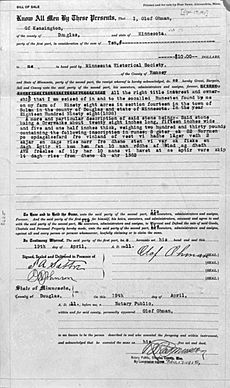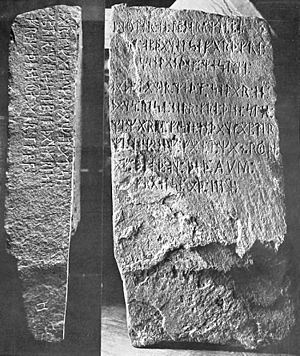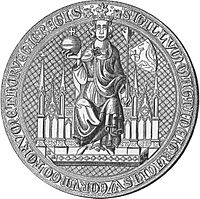Kensington Runestone facts for kids
Quick facts for kids Kensington Runestone |
|
|---|---|

The stone on display in the Alexandria Chamber of Commerce and Runestone Museum
|
|
| Created | 19th century |
| Discovered | 1898 CE Originally Kensington; currently located at Alexandria, Minnesota, United States |
| Discovered by | Olof Öhman |
| Runemaster | Disputed |
| Text – Native | |
| Swedish dialects 8 : göter : ok : 22 : norrmen : po : |
|
| Translation | |
| (word-for-word): Eight Götalanders and 22 Northmen on (this?) exploration journey from Vinland far to the west. We had a camp by two (shelters?) one day's journey north from this stone. We were fishing one day. After we came home, found 10 men red from blood and dead. Ave Maria save from evil. (side of stone) There are 10 men by the inland sea to look after our ships fourteen days journey from this peninsula (or island). Year 1362 |
|
The Kensington Runestone is a slab of greywacke stone covered in runes that was allegedly discovered in central Minnesota in 1898. Olof Öhman, a Swedish immigrant, reported that he unearthed it from a field in the largely rural township of Solem in Douglas County. It was later named after the nearest settlement, Kensington.
The inscription purports to be a record left behind by Scandinavian explorers in the 14th century (internally dated to the year 1362). There has been a drawn-out debate regarding the stone's authenticity, but since the first scientific examination in 1910, the scholarly consensus has classified it as a 19th-century hoax, with some critics directly charging Öhman with fabrication. Nevertheless there remains a community convinced of the stone's authenticity.
Provenance
Swedish immigrant Olof Öhman said that he found the stone late in 1898 while clearing land he had recently acquired of trees and stumps before plowing. The stone was said to be near the crest of a small knoll rising above the wetlands, lying face down and tangled in the root system of a stunted poplar tree estimated to be from less than 10 to about 40 years old. The artifact is about 30 × 16 × 6 inches (76 × 41 × 15 cm) in size and weighs 202 pounds (92 kg). Öhman's 10-year-old son Edward noticed some markings, and the farmer later said he thought they had found an "Indian almanac".
During this period, the journey of Leif Ericson to Vinland (North America) was being widely discussed and there was renewed interest in the Vikings throughout Scandinavia, stirred by the National Romanticism movement. Five years earlier Norway had participated in the World's Columbian Exposition by sending the Viking, a replica of the Gokstad ship, to Chicago. There was also friction between Sweden and Norway (which ultimately led to Norway's independence from Sweden in 1905). Some Norwegians claimed the stone was a Swedish hoax and there were similar Swedish accusations because the stone references a joint expedition of Norwegians and Swedes. It is thought to be more than coincidental that the stone was found among Scandinavian newcomers in Minnesota, still struggling for acceptance and quite proud of their Nordic heritage.
A copy of the inscription made its way to the University of Minnesota. Olaus J. Breda (1853–1916), professor of Scandinavian Languages and Literature in the Scandinavian Department, declared the stone to be a forgery and published a discrediting article which appeared in Symra in 1910. Breda also forwarded copies of the inscription to fellow linguists and historians in Scandinavia, such as Oluf Rygh, Sophus Bugge, Gustav Storm, Magnus Olsen and Adolf Noreen. They "unanimously pronounced the Kensington inscription a fraud and forgery of recent date".
The stone was then sent to Northwestern University in Evanston, Illinois. Scholars either dismissed it as a prank or felt unable to identify a sustainable historical context and the stone was returned to Öhman. Hjalmar Holand, a Norwegian-American historian and author, claimed Öhman gave him the stone. However, the Minnesota Historical Society has a bill of sale showing Öhman sold them the stone for $10 in 1911. Holand renewed public interest with an article enthusiastically summarizing studies that were made by geologist Newton Horace Winchell (Minnesota Historical Society) and linguist George T. Flom (Philological Society of the University of Illinois), who both published opinions in 1910.
According to Winchell, the tree under which the stone was found had been destroyed before 1910. Several nearby poplars that witnesses estimated as being about the same size were cut down and, by counting their rings, it was determined they were around 30–40 years old. One member of the team who had excavated at the find site in 1899, county school superintendent Cleve Van Dyke, later recalled the trees being only 10 or 12 years old. The surrounding county had not been settled until 1858, and settlement was severely restricted for a time by the Dakota War of 1862 (although it was reported that the best land in the township adjacent to Solem, Holmes City, was already taken by 1867, by a mixture of Swedish, Norwegian and "Yankee" settlers).
Winchell estimated that the inscription was roughly 500 years old, by comparing its weathering with the weathering on the backside, which he assumed was glacial and 8000 years old. He also stated that the chisel marks were fresh. More recently geologist Harold Edwards has also noted that "The inscription is about as sharp as the day it was carved ... The letters are smooth showing virtually no weathering." Winchell also mentions in the same report that Prof. W. O. Hotchkiss, state geologist of Wisconsin, estimated that the runes were "at least 50 to 100 years". Meanwhile, Flom found a strong apparent divergence between the runes used in the Kensington inscription and those in use during the 14th century. Similarly, the language of the inscription was modern compared to the Nordic languages of the 14th century.
The Kensington Runestone is on display at the Runestone Museum in Alexandria, Minnesota.
Text and translation
The text consists of nine lines on the face of the stone, and three lines on the edge, read as follows:
Front:
- 8 : göter : ok : 22 : norrmen : po :
- ...o : opdagelsefärd : fro :
- vinland : of : vest : vi :
- hade : läger : ved : 2 : skjär : en :
- dags : rise : norr : fro : deno : sten :
- vi : var : ok : fiske : en : dagh : äptir :
- vi : kom : hem : fan : 10 : man : röde :
- af : blod : og : ded : AVM :
- frälse : äf : illü.
Side:
- här : (10) : mans : ve : havet : at : se :
- äptir : vore : skip : 14 : dagh : rise :
- from : deno : öh : ahr : 1362 :
The sequences rr, ll and gh represent actual digraphs. The AVM is written in Latin capitals. The numbers given in Arabic numerals in the above transcription are given in the pentimal system. At least seven of the runes, including those transcribed a, d, v, j, ä, ö above, are not in any standard known from the medieval period (see below for details). The language of the inscription is close to modern Swedish, the transliterated text being quite easily comprehensible to any speaker of a modern Scandinavian language. The language, being closer to the Swedish of the 19th than of the 14th century, is one of the main reasons for the scholarly consensus dismissing it as a hoax.
The text translates to:
"Eight Geats and twenty-two Norwegians on an exploration journey from Vinland to the west. We had camp by two skerries one day's journey north from this stone. We were [out] to fish one day. After we came home [we] found ten men red of blood and dead. AVM (Ave Virgo Maria) save [us] from evil."
"[We] have ten men by the sea to look after our ships, fourteen days' travel from this island. [In the] year 1362."
Purported historical context
Norse colonies are known to have existed in Greenland from the late 10th century to at least the 14th century, and at least one short-lived settlement was established in Newfoundland, at L'Anse aux Meadows, in the 11th century, but no other widely accepted material evidence of Norse contact with the Americas in the pre-Columbian era has yet emerged. Still, there is some limited documentary evidence for possible 14th-century Scandinavian expeditions to North America.
In a letter by Gerardus Mercator to John Dee, dated 1577, Mercator refers to a Jacob Cnoyen, who had learned that eight men returned to Norway from an expedition to the Arctic islands in 1364. One of the men, a priest, provided the King of Norway with a great deal of geographical information. In the early 19th century, Carl Christian Rafn mentioned a priest named Ivar Bardarsson who had previously been based in Greenland and turns up in Norwegian records from 1364 onward.
Furthermore, in 1354, King Magnus Eriksson of Sweden and Norway issued a letter appointing a law officer named Paul Knutsson as leader of an expedition to the colony of Greenland, in order to investigate reports that the population was turning away from Christian culture. Another of the documents reprinted by the 19th-century scholars was a scholarly attempt by Icelandic Bishop Gisli Oddsson, in 1637, to compile a history of the Arctic colonies. He dated the Greenlanders' fall away from Christianity to 1342 and claimed that they had turned instead to America. Supporters of a 14th-century origin for the Kensington Runestone argue that Knutson may, therefore, have travelled beyond Greenland to North America in search of renegade Greenlanders, whereupon most of his expedition was killed in Minnesota, leaving just the eight voyagers to return to Norway.
However, there is no evidence that the Knutson expedition ever set sail (the government of Norway went through considerable turmoil in 1355) and the information from Cnoyen as relayed by Mercator states specifically that the eight men who came to Norway in 1364 were not survivors of a recent expedition, but descended from the colonists who had settled the distant lands several generations earlier. Those early 19th-century books, which aroused a great deal of interest among Scandinavian Americans, would have been available to a late 19th-century hoaxer.
Hjalmar Holand adduced the "blond" Indians among the Mandan on the Upper Missouri River as possible descendants of the Swedish and Norwegian explorers. This was dismissed as "tangential" to the Runestone issue by Alice Beck Kehoe in her 2004 book The Kensington Runestone, Approaching a Research Question Holistically.
One possible route of such an expedition, connecting the Hudson Bay with Kensington, would lead up either Nelson River or Hayes River, through Lake Winnipeg, then up the Red River of the North. The northern waterway begins at Traverse Gap, on the other side of which is the source of the Minnesota River, which flows south to join the Mississippi River at Saint Paul/Minneapolis. This route was examined by Flom (1910), who found that explorers and traders had come from Hudson Bay to Minnesota by this route decades before the area was officially settled.
Literature





